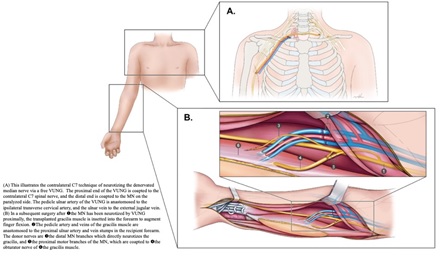Recycling Motor Branches of Median Nerve to Innervate Functioning Free Muscle Transplantation for Finger Flexion in Total Brachial Plexus Palsy
Jennifer An-Jou Lin, MD, Johnny Chuieng- Yi Lu, MD, Luis Mata Ribeiro, MD, Tommy Nai-Jen Chang, MD and David Chwei-Chin Chuang, MD
Chang Gung Memorial Hospital, Linkou Medical Center, Taoyuan
Background:
In total brachial plexus palsy, the paucity of donor nerves runs contradictory to the overwhelming number of paralyzed limb functions. Functional hand reconstruction is often neglected for the sake of preserving donor nerves for other functions. Here we describe the neurotization of a transplanted gracilis- free functioning muscle transplantation (FFMT) using previously neurotized median nerve (MN) branches after vascularized ulnar nerve graft reconstruction.
Methods:
Between 1998 and 2017, a total of 34 patients received gracilis-FFMT for finger flexion, using previously reinnervated MN motor branches as the motor neurotizer. The muscle power of finger flexion (MRC) and the satisfactory rate (?M2) were recorded. The patient-reported outcomes, including the quick DASH (disabilities of the arm, shoulder and hand) questionnaire and the Michigan Hand Outcomes Questionnaire (MHQ) were obtained.
Results:
Near half (47.1%) of the patients had a finger flexion muscle power greater than M2 after FFMT. The average postoperative Quick DASH score significantly decreased from 76.3±13.8 to 65±15.8 (p=0.042). The overall MHQ score showed significant improvement in the domains of overall hand function and work.
Conclusion:
FFMT neurotized by previously innervated MN branches can augment finger flexion to improve quality of life. The surgical strategy of recycling previously innervated median nerve to a FFMT provides efficient use of donor nerves in reconstruction for total brachial plexus palsy.

Back to 2024 Abstracts


